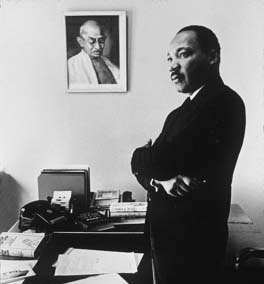Martin Luther King, Jr. & Gandhi

Mohandas K. Gandhi was born on 2 October 1869 into a family of moderate wealth in western India. Trained as a lawyer, he would go on to demonstrate against racism in South Africa and colonial rule in India, using a technique of satyagraha, or nonviolent resistance. A testament to the revolutionary power of nonviolence, Gandhi directly influenced Martin Luther King, Jr., who argued that "the Gandhian philosophy of nonviolence is the only logical and moral approach to the solution of the race problem in the United States."
... more ...
While in prison, Gandhi began a fast to protest the policy of separate electorates for untouchables—those who occupied India's lowest caste—within India's new constitution. The fast elicited public attention, helped to refocus attention on the problem of untouchability, and resulted in a major campaign. A resolution was passed by India's Constituent Assembly in 1947 making the practice of untouchability illegal. It was a historic decision that the New York Times compared with the abolition of slavery.
Despite Gandhi's urgings, on 15 August 1947, in the midst of violence and rioting, Britain transferred power to a partitioned India, creating the two independent states of India and Pakistan. Gandhi was dejected by the sacrifice of unity in India's independence, as he wrote, "it would be on the question of Hindu-Moslem unity that my Ahimsa [nonviolence] would be put to its severest test."
On 30 January 1948, Gandhi was assassinated while entering a prayer meeting in New Delhi. The man who demonstrated to the world the revolutionary power of nonviolence to counter racism in South Africa, colonial rule in India, and the economic exploitation of workers and peasants was gone; but Gandhi’s philosophy of nonviolence would go on to directly influence Martin Luther King, Jr. and the American civil rights movement, as well as many other nonviolent struggles throughout the world.

Martin Luther King, Jr. walking up to the Samadhi (cremation site) of Mahatma Gandhi, 1959. Royal Studio.
0 Comments:
Post a Comment
<< Home